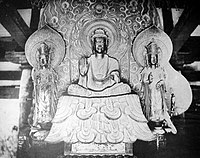Tori Busshi
The artist's work epitomizes Japanese sculpture during the era, with its solid, geometric figures in front-oriented, characteristic poses.
The position was hereditary, and the ornamentation common for saddles at the time familiarized them and young Tori with metal casting, lacquer working, and wood carving.
[4] Tori Busshi's first known work is a bronze Shaka image of Asuka-dera, Asuka, Nara Prefecture, which he finished in 606.
[5] The work made a favorable impression on Empress Suiko, and she granted Tori lands and rank equivalent to those of someone of the later fifth grade.
[7] An inscription on the back of the halo states that Empress Suiko (r. 593-629) and other courtiers commissioned the piece after the deaths of two notable court ladies in 621 and the sickness of Shōtoku and his consort the following year.
[11] What distinguishes Tori's works is that it conveys peace and softness despite a rigid adherence to stock poses and geometrical features.
[12] Tori's Buddha figures sit with an upright posture and crossed legs, their robes cascading down the body in regular, well defined folds.
His head is surrounded by a flaming halo, in which are seated the Seven Buddhas of the Past (previous incarnations of Buddhahood preceding Shaka).

